Home » Every Symbol of Goddess Hecate with Pictures and Meanings
Every Symbol of Goddess Hecate with Pictures and Meanings
Each Hecate symbol has a story to tell, revealing more of who she was and what she meant to ancient Greeks.
Often hailed as the ‘Queen of Witches’ or the ‘Goddess of the Crossroads,’ her persona is richly adorned with a myriad of objects, each narrating tales of her dominion over the earth, sky and underworld.
Among the symbols of Hecate are the torch, key, and dagger. Each one resonates with her aura of ancient wisdom and mystique.
And don’t forget her sacred dogs—guardians and protectors, they embody loyalty and intuition.
This guide explores all the goddess Hecate symbols, as well as the animals she’s associated with.
So whether you’re a mythology buff or just curious, learning about the objects associated with her offers a riveting exploration into ancient beliefs about the physical and the mystical.
Let’s start unravelling the mysteries of these ancient Hecate symbols and their enduring influence.
Hecate Symbols and Their Meaning
Here’s the individual meaning for all Hecate symbols and objects…
1. Moon Symbol
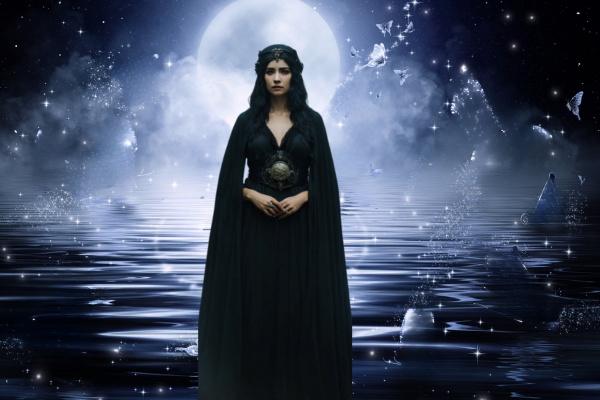
The moon is one of the more well-known signs representing this goddess. Its ever-changing phases mirror the cycles of life and death, a domain she governs.
The moon transitions from darkness to full brilliance. Its glow can guide travelers in the dark, illuminating paths and revealing hidden truths.
This guiding quality aligns with her role as a divine escort through the complexities of life.
The moon’s dark side also speaks to the mysteries and hidden knowledge that she holds.
It’s a symbol of the subconscious, the emotional depths, and the mystical elements that exist in parallel with our everyday world.
In modern pagan practices, moon rituals are often dedicated to her.
The moon becomes a focal point, drawing practitioners closer to the arcane wisdom and transformative gifts she embodies.
By connecting the moon as one of the symbols of Hecate, followers believe they can tap into their own intuitive abilities and delve into the mysteries of the self and the universe.
2. Key Symbol
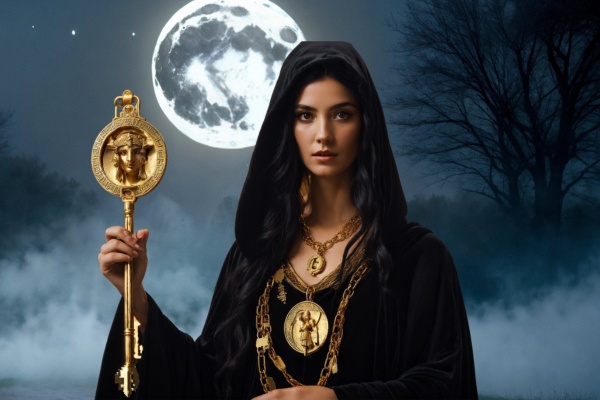
The key is a powerful Hecate symbol that showcases one of her many spheres of influence.
Her realms are places of transition, and keys unlock these mysteries.
They open doors to other worlds, revealing hidden knowledge.
In her role as a guardian of thresholds, a key fits perfectly. It signifies her authority to grant or deny access to the divine and the underworld.
Hecate often holds a key in ancient art, reinforcing her capabilities to unlock the door to new pathways.
She decides who can pass through spiritual and physical barriers.
In ancient times, these mechanisms were scarce and symbolized influence and privilege.
Hecate with a key represents her control over all of these things.
And it reminds us of her wisdom to understand deeper spiritual layers.
3. Triple Goddess Symbolism
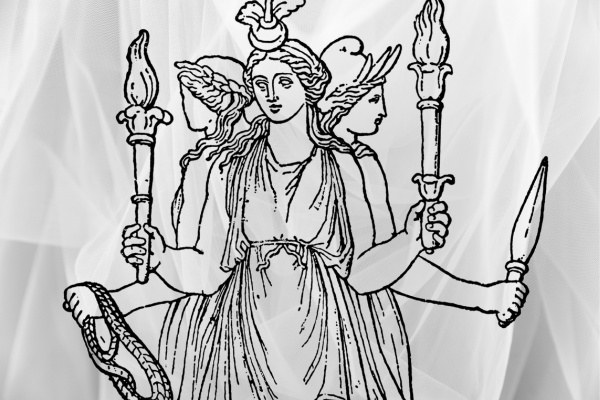
This is one of her most famous depictions.
The Triple Goddess concept refers to the three aspects of the divine feminine: Maiden, Mother, and Crone.
It’s one of those Hecate symbols that takes on a unique flavor.
Like the picture above, her three forms are usually seen as three identical women standing back-to-back, each holding an object that came to represent her.
Each of her three forms can represent different aspects of her complex nature.
One could symbolize her role as a guide through life’s journeys.
Another could represent her connection to magic and the underworld.
The third might embody her aspect as a protector or giver of wisdom.
In modern witchcraft and Wicca, Hecate’s Triple Goddess form is often called upon for rituals involving transformation, protection, and wisdom.
Her threefold nature makes her versatile, allowing her to assist in various aspects of life and spiritual growth.
This depiction of her is so popular that you can actually find statues for sale showing the triple-goddess, just like the image above.
Now let’s take a look at the objects she’s holding that also became Goddess Hecate symbols and were representative of who she was in ancient spirituality…
4. Rope Symbol
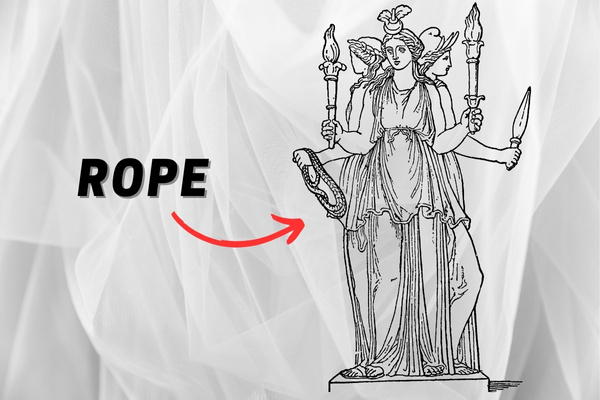
In her famous depiction as a triple goddess, she is holding a rope.
This rope became a symbol of Hecate because of this portrayal.
The tool embodies the idea of connection and binding, themes that run deep in her lore.
Ropes serve practical purposes like fastening and holding things together.
In a spiritual sense, they represent the ties that bind different realms, from the earthly to the divine and the underworld.
A rope can signify the connection between life and death, a concept she governs as a liminal deity.
In ceremonies honoring a goddess, incorporating a rope can symbolize drawing boundaries or pulling energies together.
So, why is the rope a Hecate symbol and representation of her?
It embodies the complex nature of boundaries, connections, and transitions, themes intrinsically tied to her role as a goddess.
It’s both a guide and a binder, mirroring her dual nature of leading and constraining.
5. Dagger Symbol
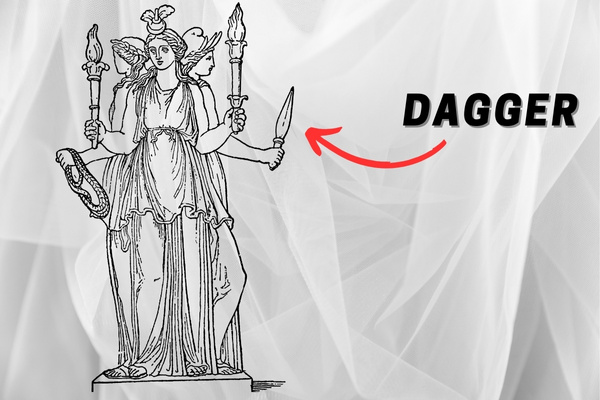
The dagger is a potent symbol associated with goddess Hecate who is known for her dominion over magic, crossroads, and transitions.
This weapon serves dual purposes: it can protect and it can harm.
This duality mirrors her own complex nature, overseeing aspects of life and death, creation, and destruction.
In ancient cultures, daggers were not just weapons; they were tools for ritualistic practices, making them even more fitting as a representation of her influence.
In magical practices, the dagger, often termed an “athame” in modern witchcraft, is used to direct energy, cast circles, or cut ties.
Holding a dagger in ritual or seeing it in art related to her evokes a sense of empowered decision-making,
This reminds followers that every choice can be a double-edged blade, with the power to liberate or confine.
As the goddess of crosswords where decisions need to be made, objects like this are fitting symbol of Goddess Hecate.
6. Hecate Torches
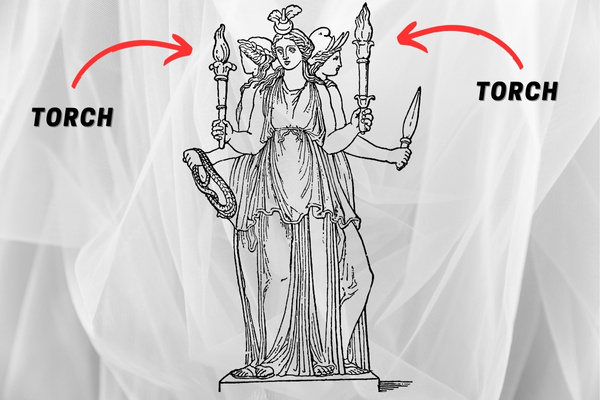
Torches are another one of those classic Hecate symbols that people still associate with her today.
Their flame has a dual nature: it illuminates the dark yet can consume what it touches.
This reflects her own dual roles, guiding individuals through dark transitions while also holding the power of transformation and destruction.
In ancient rituals and depictions, torches are commonly seen as her attribute.
They serve as beacons, leading souls through the unknown.
The flame lights up the darkness, revealing both opportunities and dangers.
It guides the lost, acting as a bridge between different realms.
Just like she guides individuals through various phases of life, the torch is a guiding light in literal and metaphorical darkness.
In essence, the torches of Hecate encapsulate a wealth of symbolic meanings: guidance, illumination, and duality.
They give us light to see and fire to transform, fitting attributes for a deity who commands such a wide range of human experiences.
7. Crossroads
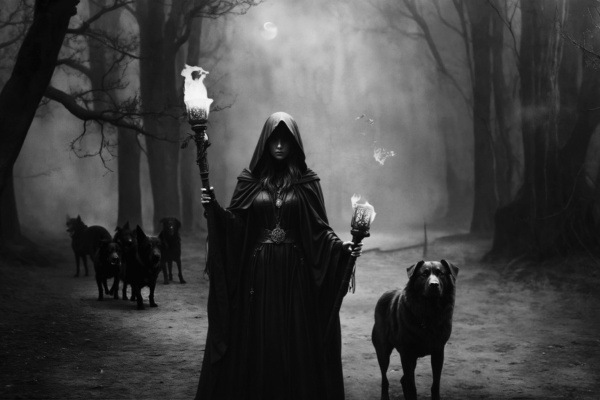
Crossroads are a striking symbol of Hecate because they too are associated with the magic and transformation.
These intersecting paths capture the essence of choices, opportunities, and potential directions one can take in life.
As a liminal space, the crossroads exist between the known and the unknown, making them places of both promise and peril.
They represent decisions that could lead to success or failure, happiness, or regret, and embody the essence of free will.
One can seek guidance, wisdom, or protection when standing at life’s metaphorical crossroads.
It becomes a place to honor the dualities she governs like life and death, young and old, spiritual and mundane.
In both ancient lore and modern practices, the crossroads remain a potent Hecate symbol for its connection to choice and opportunities.
8. The Cauldron
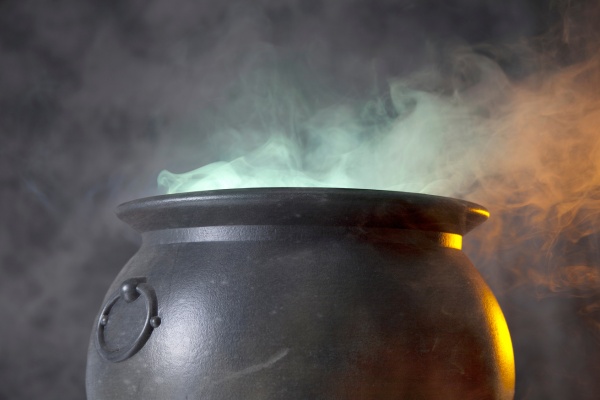
This is one of those Goddess Hecate symbols that many people associate with her because of her influence over magic.
She is often associated with witchcraft and the supernatural.
The cauldron has long been a powerful symbol in these realms, frequently depicted as a vessel for brewing potions and casting spells. As the goddess of magic, her connection to the cauldron is a natural one.
It’s a representation for one of the many Hecate powers in the realms of witchcraft and the underworld. That makes it a fitting calling card for this ancient deity.
In magical practices, the cauldron is a focal point for spells and rituals.
It’s a symbol of alchemy, transformation, and the blending of different elements—much like Hecate herself.
9. Colors of Hecate

Black and red are often considered Hecate colors and symbols.
They symbolize the night, mystery, and the unknown—all realms where she holds sway.
Some also link silver to her because of her connection to the moon. These colors capture the essence of her mystical nature.
Black isn’t just a color; it’s a canvas for her work in the realms of magic and the unknown.
It embodies the depth and mystery that surround her.
It’s the color used when followers are holding ceremonies during their worship of Hecate.
When you think of the underworld or a moonless night, black comes to mind, right? That’s her territory.
Dark red adds another layer.
It evokes a sense of spiritual clout and intuition.
And then there’s silver—the color of the moon.
It reflects her lunar associations and her role as a guide in both physical and spiritual journeys. Silver captures the dual nature of the moon: a guiding light in darkness, yet ever-changing.
So, these Hecate symbols and colors aren’t just shades on a palette.
They’re keys to understanding the depths of her character and influence.
10. Circle
The circle is a potent symbol often linked to goddess Hecate.
It encapsulates the idea of cycles, change, and eternal movement, themes that are central to her mythology.
In ancient traditions, this ring was not just a physical object but a representation of the cosmic cycle of life, death, and rebirth.
It captures the essence of time’s endless turning and the ever-changing phases of existence.
For more info on this symbol, check out our wheel of Hecate guide.
Sacred Animals of Hecate
When it comes to Greek mythology, Hecate stands out as a goddess of many realms—moon, magic, and crossroads, to name a few.
But one often-overlooked aspect is her association with sacred animals, each adding another layer of character.
Let’s explore the significance of these creatures that became Hecate symbols.
Hecate and Her Sacred Dogs
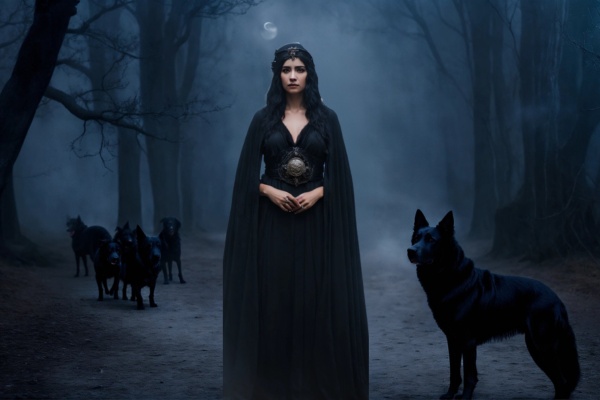
When it comes to Greek mythology, Hecate stands out as a goddess of many realms—moon, magic, and crossroads, to name a few.
But one often-overlooked aspect is her association with sacred animals, each adding another layer of character.
Let’s explore the significance of these creatures that became Hecate symbols.
First up, the hounds. These are perhaps the most well-known of Hecate’s sacred animals.
In many depictions of the goddess, she is accompanied by dogs who serve as faithful guardians or companions on her journeys between worlds.
These dogs are not mere pets but hold deep symbolic meaning within Greek mythology.
They are believed to possess heightened senses and an innate ability to perceive things beyond the human realm.
Just like goddess Hecate herself, these loyal canines act as protectors and guides for those venturing into unknown territories.
Their presence signifies their role in safeguarding individuals during times of transition or when exploring mystical realms.
Often seen as spectral dogs or hellhounds, they serve as her loyal companions.
And they’ve remained popular Hecate symbols for a long time now.
The Polecat
Another less common but interesting animal associated with Hecate is the polecat. According to some tales, the goddess was followed by a she-dog and a polecat.
The polecat was said to be either her familiar or a transformed witch. Polecats, like other animals tied to witchcraft or magic, symbolized the supernatural.
Another reason for this connection is that she’s a chthonic deity linked to the underworld and Polecats are creatures that can navigate both above and below ground.
This association paints a vivid picture of her connection to witchcraft and the unseen realms.
Like many other symbols of Hecate, this one deepens the intrigue around her character, emphasizing her mastery over the mystical and the arcane.
Ravens
Ravens are commonly associated with omens and the unknown, fitting for a goddess of the crossroads.
And that’s why this animal came to be associated with Hecate.
They are often seen as messengers of the afterlife or symbols of the underworld in various mythologies.
Their dark plumage and eerie calls echo the enigmatic aura surrounding this goddess, further intertwining their symbolism.
This shared connection to the mysterious realms could foster an association between her and ravens, illustrating the intricate web of symbols that enrich Greek mythology.
However, specific information regarding the association of the two isn’t readily available.
So this association might come from general attributes of mystery, magic, and the underworld.
Conclusion of the Symbols of Hecate
We’ve journeyed through a fascinating landscape filled with torches, keys, dogs, mystical colors, and even a cauldron.
These symbols of Hecate are way more than cool illustrations; they represent the essence of the goddess herself.
They give us glimpses into her versatile roles—from being a guide in the darkness to unlocking the secrets of the unknown and even standing guard at life’s crossroads.
Understanding these representations deepens our connection to the goddess, bringing us closer to grasping her ancient wisdom and complexities.
Every Hecate symbol offers a unique lens to view her, a goddess as complex as she is captivating.
These aren’t just random icons; they’re layers of a rich tapestry that make up her character.
They show us that she is not just a goddess of one thing, but a deity of many realms—be it the underworld, the moon, or the crossroads of life itself.
Thanks for joining us on this intriguing journey through the Hecate symbols and associated animals.
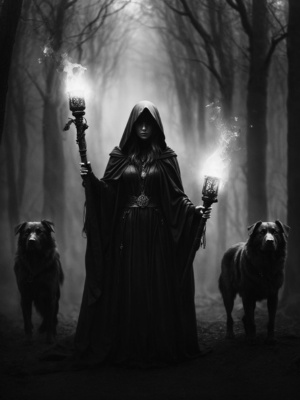
2024 All rights reserved.
